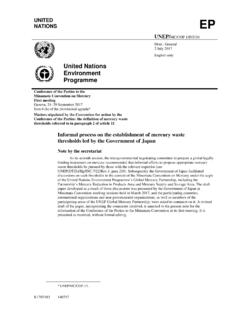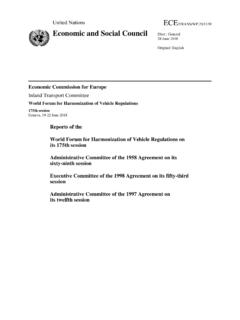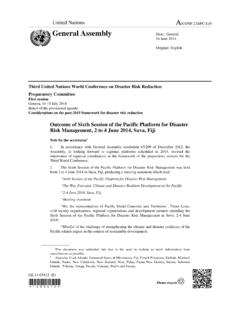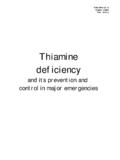Transcription of WHO/MNH/MHP/98.4. Distr.: General DRAFT
1 WHO/MNH/ English only distr .: General DRAFT WHOQOL User Manual PROGRAMME ON MENTAL HEALTH DIVISION OF MENTAL HEALTH AND PREVENTION OF SUBSTANCE ABUSEWORLD HEALTH ORGANIZATIONWHO/MNH/ English only distr .: General WHOQOL User Manual PROGRAMME ON MENTAL HEALTH DIVISION OF MENTAL HEALTH AND PREVENTION OF SUBSTANCE ABUSE WORLD HEALTH ORGANIZATION 1998 This manual is intended to help users of the WHOQOL-100 and WHOQOL_BREF in administering and scoring of the instruments. It also describes the process of developing the instruments and their psychometric properties World Health Organization 1998 This document is not a formal publication of the World Health Organization (WHO) and all rights are reserved by the Organization.
2 The document may, however, be freely reviewed, abstracted, reproduced or translated in part, but not for sale or for use in conjunction with commercial purposes. It may also be reproduced in full by non-commercial entities for information or for educational purposes with prior permission from WHO. For authorization to translate the work in full, and for any use by commercial entities, applications and inquiries should be addressed to the Department of Mental Health, World Health Organization, 1211 Geneva 27, Switzerland, which will be glad to provide the latest information on any changes made to the text, plans for new editions, and the reprints, adaptations and translations that may already be available. The views expressed herein by named authors are solely the responsibility of those authors. For further copies of this document Please write to Programme on Mental Health World Health Organization 1211 Geneva 27, Switzerland e-mail.
3 TABLE OF CONTENTS INTRODUCTION Page Purpose of this Manual 1 Summary of WHOQOL Instruments 1 Uses of the WHOQOL Instruments 1 Outline of Chapters 1 CHAPTER 1 - DEVELOPMENT OF THE WHOQOL-100 Introduction 2 Rationale for the Development of the WHOQOL 2 Conceptual Background 3 The WHOQOL Method 3 Steps in the Development of the WHOQOL-100 5 Final Structure of the WHOQOL-100 11 CHAPTER 2 - PSYCHOMETRIC PROPERTIES OF THE WHOQOL-100 Introduction 13 Sample Population Used to Determine Psychometric Properties 14 Statistical Analysis 14 Confirmatory Factor Analysis of the WHOQOL-100 Structure 14 Discriminant Validity 17 Internal Consistency 19 Test-retest Reliability 19 Importance of Domains in Assessing Overall Quality of Life 19 CHAPTER 3 - PREPARATION AND ADMINISTRATION OF THE WHOQOL-100 Access to the WHOQOL-100 22 Preparation of the WHOQOL-100 23 WHOQOL-100 Administration 23 Time taken to complete the
4 WHOQOL-100 23 Frame of Reference and Time Frame 24 User Agreement 24 CHAPTER 4 - DEVELOPMENT OF THE WHOQOL-100 IN A NEW LANGUAGE Introduction 26 Appropriateness of the WHOQOL-100 in New Centres 26 Appropriateness of the WHOQOL Domain and Facet Structure 27 Translation of the WHOQOL Facet Definitions and Core Items 28 Conduct of Focus Groups 30 Question Writing Work for National Items 31 Development of Reponse Scales 32 Construction of Pilot Instrument, Pre-testing and Piloting 33 Administration of the Pilot WHOQOL 33 CHAPTER 5 - DEVELOPMENT OF THE WHOQOL-BREF Introduction 35 Sample Population Used to Select Items for the WHOQOL-BREF 35 Method Used to Select Items for the WHOQOL-BREF 36 Calculation of Domain Scores 36 Confirmatory Factor Analysis of the WHOQOL-BREF Structure 36 Comparison Between WHOQOL-100 and WHOQOL-BREF Scores 39 Internal Consistency 39 Discriminant Validity 40
5 Importance of Domains in Assessing Overall Quality of Life 41 CHAPTER 6 - PREPARATION AND ADMINISTRATION OF THE WHOQOL-BREF Access to the WHOQOL-BREF 42 Preparation of the WHOQOL-BREF 42 WHOQOL-BREF Administration 42 Frame of Reference and Time Frame 43 CHAPTER 7 - PROPOSED USES OF THE WHOQOL-100 AND THE WHOQOL-BREF 44 CHAPTER 8 - SCORING OF THE WHOQOL-100 AND THE WHOQOL-BREF Introduction 45 Scoring of the WHOQOL-100 45 Facet Scores 45 Domain Scores 46 Transformation of Scores to A 0-100 Scale 46 Missing Data 46 Syntax Files for Automatic Computation of Scores Using SPSS 47 Scoring of the WHOQOL-BREF 47 REFERENCES 48 APPENDIX 1 - FACET DEFINITIONS AND RESPONSE SCALES 50 APPENDIX 2 - CRITERIA FOR GENERATING AND SELECTING WHOQOL ITEMS 60 APPENDIX 3 - NUMBER OF QUESTIONS SELECTED FOR PILOT WHOQOL (236 QUESTIONS) AND FIELD TRIAL WHOQOL (100 QUESTIONS)
6 FROM EACH OF THE MAIN STUDY FIELD CENTRES 61 APPENDIX 4 - THE WHOQOL-100 62 APPENDIX 5 - CORRESPONDENCE ADDRESSES FOR FIELD CENTRES 74 APPENDIX 6 - FOCUS GROUP INTERVIEW SCHEDULE 77 APPENDIX 7 - WHOQOL-100 IMPORTANCE QUESTIONS 79 APPENDIX 8 - THE WHOQOL-BREF 83 APPENDIX 9 STEPS FOR CHECKING AND CLEANING DATA AND COMPUTING DOMAIN SCORES FOR THE WHOQOL-100 86 APPENDIX 10 - STEPS FOR CHECKING AND CLEANING DATA AND COMPUTING DOMAIN SCORES FOR THE WHOQOL-BREF 88 INTRODUCTION PURPOSE OF THIS MANUAL This manual aims to describe the development and use of the WHOQOL-100 and WHOQOL-BREF quality of life assessments, giving the reader a background on the development of the WHOQOL instruments, describing their psychometric properties and facilitating administration and scoring. SUMMARY OF WHOQOL INSTRUMENTS The WHOQOL-100 assesses individuals' perceptions of their position in life in the context of the culture and value systems in which they live and in relation to their goals, expectations, standards and concerns.
7 It was developed collaboratively in some 15 cultural settings over several years and has now been field tested in 37 field centres. It is a 100-question assessment that currently exists in directly comparable forms in 29 language versions. It yields a multi-dimensional profile of scores across domains and sub-domains (facets) of quality of life. More recently, the WHOQOL-BREF, an abbreviated 26 item assessment has been developed. USES OF THE WHOQOL INSTRUMENTS The WHOQOL-100 and WHOQOL-BREF have many uses, including use in medical practice, research, audit, policy making and in assessing the effectiveness and relative merits of different treatments. They can also be used to assess variation in quality of life across different cultures, to compare subgroups within the same culture and to measure change across time in response to change in life circumstances.
8 OUTLINE OF CHAPTERS The initial chapter describes the rationale for the development of the WHOQOL pilot instrument and the refinement of the original WHOQOL pilot instrument to produce the WHOQOL-100. Chapter 2 reports on the psychometric properties of the WHOQOL-100, whilst Chapter 3 gives guidelines for the preparation and administration of the WHOQOL-100. Chapter 4 serves as a resource for researchers who wish to develop the WHOQOL-100 in a new language version, whilst Chapters 5 and 6 outline the development, psychometric properties and administration procedures for the WHOQOL-BREF. Finally, Chapter 7 outlines some of the proposed uses for the WHOQOL-100 and WHOQOL-BREF and Chapter 8 details their scoring procedures. CHAPTER ONE - DEVELOPMENT OF THE WHOQOL-100 INTRODUCTION The WHOQOL-100 was produced from an original WHOQOL pilot assessment.
9 This chapter briefly describes the rationale for the development of the WHOQOL pilot assessment, its conceptual background and the method used in its development. It also describes the development of the WHOQOL-100 from the WHOQOL pilot assessment. RATIONALE FOR THE DEVELOPMENT OF THE WHOQOL WHO's initiative to develop a quality of life assessment arose for a number of reasons. In recent years there has been a broadening of focus in the measurement of health, beyond traditional health indicators such as mortality and morbidity ( World Bank, 1993; WHO, 1991), to include measures of the impact of disease and impairment on daily activities and behaviour ( Sickness Impact Profile; Bergner, Bobbitt, Carter et al, 1981), perceived health measures ( Nottingham Health Profile; Hunt, McKenna and McEwan, 1989) and disability / functional status measures ( the MOS SF-36, Ware et al, 1993).
10 These measures, whilst beginning to provide a measure of the impact of disease, do not assess quality of life per se, which has been aptly described as "the missing measurement in health" (Fallowfield, 1990). Second, most measures of health status have been developed in North America and the UK, and the translation of these measures for use in other settings is time-consuming and unsatisfactory for a number of reasons (Sartorius and Kuyken, 1994; Kuyken, Orley, Hudelson and Sartorius, 1994). Third, the increasingly mechanistic model of medicine, concerned only with the eradication of disease and symptoms, reinforces the need for the introduction of a humanistic element into health care. Health care is essentially a humanistic transaction where the patient's well-being is a primary aim.

















